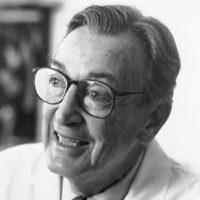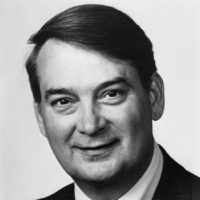
Robert F. Furchgott
State University of New York, Health Science Center at Brooklyn

Ferid Murad
Molecular Geriatrics Corporation
For discoveries concerning the endothelium-derived relaxing factor (EDRF), now known to be nitric oxide, a signaling molecule in the cardiovascular system. For the ingenious elucidation of the cyclic GMP signaling pathway of nitric oxide and for essential discoveries that led to establishing the link between endothelium-derived relaxing factor and nitric oxide.
Robert Furchgott
For more than four decades, Robert Furchgott has worked to unravel the mystery of how drugs interact with receptors in the blood vessels, achieving stunning results that form the basis for modern concepts of receptor pharmacology.
In the 1950s, one of Dr. Furchgott’s earliest contributions was the development of a laboratory method for studying how living blood vessels react to hormones, neurotransmitters and drugs. Using a helically cut, long strip of rabbit aorta in an organ chamber attached to a device that measured contractions and relaxations, he was the first to quantify accurately the effects of pharmacological agents on vascular smooth muscle.
During his early studies on arteries, he also discovered and studied the phenomenon of photorelaxation, a relaxation of the vascular smooth muscle when exposed to ultraviolet light.
As important as these advances were, they only laid the foundation for his later work which, despite its simplicity, has opened the door to a prodigious amount of critical research in cardiovascular disease, immune defense in degenerative diseases, and stroke, among others.
This was the discovery in 1980 of a substance in the endothelium, a layer of cells at the innermost surface of blood vessels, which causes the underlying smooth muscle to relax—a substance he called endothelium-derived relaxing factor, or EDRF. It was the first time attention had been called to this crucial role that endothelium plays in cardiovascular health and disease. The substance, though, was mysterious—it appeared only briefly and eluded attempts to capture and identify it.
It took another six years for Dr. Furchgott and others to make the remarkable discovery that EDRF was in actuality nitric oxide, a simple but extremely labile chemical that has played a role in the management of cardiovascular disease for more than 100 years. (A clue was found in nitroglycerin, used since the last century to control the chest pains associated with heart disease, which breaks down into nitric oxide.) Dr. Furchgott observed that EDRF was released by a number of agents acting on endothelial receptors. The release of EDRF was shown by others to interfere with the aggregation of platelets and the adhesion of platelets to blood vessel walls, thereby preventing the formation of small blood clots. This effect, combined with the vasodilating effect of EDRF, keeps blood vessels open and facilitates blood flow.
Later research has shown that nitric oxide or EDRF is a messenger molecule involved in a wide range of activities. It mediates the control of blood pressure and blood flow, airway tone, gastrointestinal motility, penile erection, and the fighting of cancer and infection. In the brain, nitric oxide is an important and unusual neurotransmitter that is revealing clues to unlock the mysteries of learning, memory, and emotion.
To Robert Furchgott, for seminal research in drug receptor interactions that led to the discovery of EDRF, which has had profound implications for the treatment of cardiovascular conditions and other diseases, this 1996 Albert Lasker Basic Medical Research Award is given.
Ferid Murad
For more than 100 years, physicians have used nitroglycerin as a vasodilator to treat angina pectoris, but its mode of action was totally obscure until the ingenious work of Ferid Murad. In the mid-1970s, Dr. Murad discovered that nitrogen-containing compounds (such as sodium azide, nitroglycerin, nitroprusside and nitric oxide) stimulate the enzyme that synthesizes cyclic GMP, the intracellular signaling molecule that causes smooth muscle cells to relax. Dr. Murad coined the term nitrovasodilators to denote this class of agents, and he postulated that all of them might be metabolized to nitric oxide (NO), which was the real chemical mediator. He also postulated that nitric oxide might be produced endogenously from a precursor to act as an intracellular messenger.
Robert Furchgott’s dramatic discovery of endothelium-derived relaxing factor (EDRF) in 1980 led scientists to search for the chemical nature of this agent. Based on Dr. Murad’s paradigm, a nitrovasodilator was suspected, and he coined the term endogenous nitrovasodilator for EDRF. Indeed in 1987, several groups of scientists independently showed that EDRF and nitric oxide were one and the same. Dr. Murad’s prediction of an endogenous nitrovasodilator was fulfilled several years after it was originally proposed.
Dr. Murad began his studies in the early 1970s with the observation that guanylyl cyclase, the enzyme that synthesizes cyclic GMP, exists in distinct soluble and particulate forms and that soluble guanylyl cyclase was activated by sodium azide. In what might have passed as a biochemical curiosity, he found that intracellular concentrations of cyclic GMP were elevated when exposed to sodium azide—a finding that led him to the broader discovery that the chemically related compounds he called nitrovasodilators also activated guanylyl cyclase.
Dr. Murad then went on to purify guanylyl cyclase and showed that it was activated by nitric oxide. He also discovered that the heat stable enterotoxin of Escherichia coli, a cause of both traveler’s diarrhea and dehydrating diarrhea common in children throughout the world and a major cause of infant mortality, produces its secretion by specific activation of particulate guanylyl cyclase. He further demonstrated that atrial natriuretic peptides (ANP) increase cyclic GMP synthesis and was the first to show that the receptor for ANP copurified to homogeneity with particulate guanylyl cyclase, an observation that led to the cloning of mammalian receptor guanylyl cyclases.
To Ferid Murad, for brilliant and ingenious elucidation of the cyclic GMP signaling pathway for nitric oxide and for essential discoveries that led to establishing the link between endothelium-derived relaxing factor and nitric oxide, this 1996 Albert Lasker Basic Medical Research Award is given.
Award presentation by Joseph Goldstein
The story of Szent-Gyorgyi’s discovery of vitamin C is a beautiful illustration, and it is directly comparable to the discovery of nitric oxide, which we honor today with the Albert Lasker Basic Medical Research Award. Szent-Gyorgyi began his scientific career by studying the chemical changes that occur when foodstuffs—carbohydrates, fats, and protein—undergo combustion when they are burned by cells—a process called biological oxidation. In the course of his studies he isolated a molecule from adrenal glands that lost and regained hydrogen atoms—a hydrogen carrier. This molecule contained six carbon atoms, had the properties of a sugar and an acid, and was originally named hexuronic acid (later renamed ascorbic acid).
